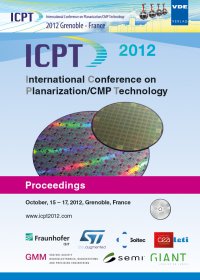Development of chemical mechanical polishing process for carbon nanotube interconnects on 300 mm wafer
Conference: ICPT 2012 - International Conference on Planarization / CMP Technology
10/15/2012 - 10/17/2012 at Grenoble, France
Proceedings: ICPT 2012
Pages: 6Language: englishTyp: PDF
Personal VDE Members are entitled to a 10% discount on this title
Authors:
Ito, Ban; Nishide, Daisuke; Matsumoto, Takashi; Katagiri, Masayuki; Saito, Tatsuro; Wada, Makoto; Watanabe, Masahito; Sakuma, Naoshi; Kajita, Akihiro; Sakai, Tadashi (Low-power Electronics Association & Project (LEAP), 16-1 Onogawa, Tsukuba, Ibaraki, 305-8569, Japan)
Abstract:
Carbon nanotubes (CNTs) have been considered as potential candidate material for nano-scale via interconnects due to their ballistic transport properties and high current density tolerance. This report describes the development of a chemical mechanical polishing (CMP) process for CNT interconnect application using a 300 mm wafer in a standard back-end-of-line (BEOL) process. Coating of the CNTs grown on the wafer with spin-on-glass (SOG) enabled to be polished without any peeling or cracking during CMP, which indicated that the CNTs are firmly fixed by the SOG. The CMP process for CNT via interconnects actually comprises two process: CNT-CMP and Touch up (Tup)-CMP. The CNT-CMP process requires selective removal of the CNT layer on the field area of the via structure, and the Tup-CMP process removes CNT, TiN, and SiO2 equally to planarize the final surface. Therefore, removal selectivity is essential for both CMP processes. As for the CNT-CMP, the removal rate of CNTSOG composite film was about 50 nm/min, and the removal selectivity value of the TiN/CNT-SOG film was about 0.1. The removal selectivity value of the CNTSOG/ SiO2 and TiN/SiO2 for Tup-CMP was about 0.8. These results demonstrate that the proposed CMP process can be used for CNT interconnect fabrication. Keywords: carbon nanotube, CNT, interconnect, CMP, 300 mm wafer, SOG, removal selectivity


